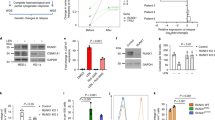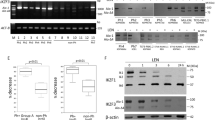Abstract
Despite the high response rates of individuals with myelodysplastic syndrome (MDS) with deletion of chromosome 5q (del(5q)) to treatment with lenalidomide (LEN) and the recent identification of cereblon (CRBN) as the molecular target of LEN, the cellular mechanism by which LEN eliminates MDS clones remains elusive. Here we performed an RNA interference screen to delineate gene regulatory networks that mediate LEN responsiveness in an MDS cell line, MDSL. We identified GPR68, which encodes a G-protein-coupled receptor that has been implicated in calcium metabolism, as the top candidate gene for modulating sensitivity to LEN. LEN induced GPR68 expression via IKAROS family zinc finger 1 (IKZF1), resulting in increased cytosolic calcium levels and activation of a calcium-dependent calpain, CAPN1, which were requisite steps for induction of apoptosis in MDS cells and in acute myeloid leukemia (AML) cells. In contrast, deletion of GPR68 or inhibition of calcium and calpain activation suppressed LEN-induced cytotoxicity. Moreover, expression of calpastatin (CAST), an endogenous CAPN1 inhibitor that is encoded by a gene (CAST) deleted in del(5q) MDS, correlated with LEN responsiveness in patients with del(5q) MDS. Depletion of CAST restored responsiveness of LEN-resistant non-del(5q) MDS cells and AML cells, providing an explanation for the superior responses of patients with del(5q) MDS to LEN treatment. Our study describes a cellular mechanism by which LEN, acting through CRBN and IKZF1, has cytotoxic effects in MDS and AML that depend on a calcium- and calpain-dependent pathway.
This is a preview of subscription content, access via your institution
Access options
Subscribe to this journal
Receive 12 print issues and online access
$209.00 per year
only $17.42 per issue
Buy this article
- Purchase on Springer Link
- Instant access to full article PDF
Prices may be subject to local taxes which are calculated during checkout





Similar content being viewed by others
Accession codes
References
Pan, B. & Lentzsch, S. The application and biology of immunomodulatory drugs (IMiDs) in cancer. Pharmacol. Ther. 136, 56–68 (2012).
List, A. et al. Myelodysplastic Syndrome-003 Study Investigators. Lenalidomide in the myelodysplastic syndrome with chromosome 5q deletion. N. Engl. J. Med. 355, 1456–1465 (2006).
Giagounidis, A.A. Lenalidomide for del(5q) and non-del(5q) myelodysplastic syndromes. Semin. Hematol. 49, 312–322 (2012).
Wei, S. et al. Lenalidomide promotes p53 degradation by inhibiting MDM2 auto-ubiquitination in myelodysplastic syndrome with chromosome 5q deletion. Oncogene 32, 1110–1120 (2013).
McDaniel, J.M., Pinilla-Ibarz, J. & Epling-Burnette, P.K. Molecular action of lenalidomide in lymphocytes and hematologic malignancies. Adv. Hematol. 2012, 513702 (2012).
Ito, T. et al. Identification of a primary target of thalidomide teratogenicity. Science 327, 1345–1350 (2010).
Krönke, J. et al. Lenalidomide induces ubiquitination and degradation of CK1-α in del(5q) MDS. Nature 523, 183–188 (2015).
Krönke, J. et al. Lenalidomide causes selective degradation of IKZF1 and IKZF3 in multiple myeloma cells. Science 343, 301–305 (2014).
Lu, G. et al. The myeloma drug lenalidomide promotes the cereblon-dependent destruction of Ikaros proteins. Science 343, 305–309 (2014).
Matsuoka, A. et al. Lenalidomide induces cell death in an MDS-derived cell line with deletion of chromosome 5q by inhibition of cytokinesis. Leukemia 24, 748–755 (2010).
Tohyama, K. et al. A novel factor-dependent human myelodysplastic cell line, MDS92, contains hemopoietic cells of several lineages. Br. J. Haematol. 91, 795–799 (1995).
Pellagatti, A. et al. Lenalidomide inhibits the malignant clone and upregulates the SPARC gene mapping to the commonly deleted region in 5q– syndrome patients. Proc. Natl. Acad. Sci. USA 104, 11406–11411 (2007).
Komurov, K., Dursun, S., Erdin, S. & Ram, P.T. NetWalker: a contextual network analysis tool for functional genomics. BMC Genomics 13, 282 (2012).
Saft, L. et al. p53 protein expression independently predicts outcome in patients with lower-risk myelodysplastic syndromes with del(5q). Haematologica 99, 1041–1049 (2014).
Gandhi, A.K. et al. Immunomodulatory agents lenalidomide and pomalidomide co-stimulate T cells by inducing degradation of T cell repressors Ikaros and Aiolos via modulation of the E3 ubiquitin ligase complex CRL4CRBN. Br. J. Haematol. 164, 811–821 (2014).
Rebollo, A. & Schmitt, C. Ikaros, Aiolos, and Helios: transcription regulators and lymphoid malignancies. Immunol. Cell Biol. 81, 171–175 (2003).
Rosenbloom, K.R. et al. ENCODE data in the UCSC Genome Browser: year 5 update. Nucleic Acids Res. 41, D56–D63 (2013).
Ludwig, M.G. et al. Proton-sensing G-protein-coupled receptors. Nature 425, 93–98 (2003).
Huang, W.C., Swietach, P., Vaughan-Jones, R.D., Ansorge, O. & Glitsch, M.D. Extracellular acidification elicits spatially and temporally distinct Ca2+ signals. Curr. Biol. 18, 781–785 (2008).
Rhyasen, G.W. et al. An MDS xenograft model utilizing a patient-derived cell line. Leukemia 28, 1142–1145 (2014).
Russell, J.L. et al. Regulated expression of pH-sensing G-protein-coupled receptor 68 identified through chemical biology defines a new drug target for ischemic heart disease. ACS Chem. Biol. 7, 1077–1083 (2012).
Frick, K.K., Krieger, N.S., Nehrke, K. & Bushinsky, D.A. Metabolic acidosis increases intracellular calcium in bone cells through activation of the proton receptor OGR1. J. Bone Miner. Res. 24, 305–313 (2009).
Clapham, D.E. Calcium signaling. Cell 131, 1047–1058 (2007).
Croall, D.E. & Ersfeld, K. The calpains: modular designs and functional diversity. Genome Biol. 8, 218 (2007).
Sorimachi, H., Hata, S. & Ono, Y. Impact of genetic insights into calpain biology. J. Biochem. 150, 23–37 (2011).
Jerez, A. et al. Topography, clinical, and genomic correlates of 5q myeloid malignancies revisited. J. Clin. Oncol. 30, 1343–1349 (2012).
Pellagatti, A. et al. Gene expression profiles of CD34+ cells in myelodysplastic syndromes: involvement of interferon-stimulated genes and correlation to FAB subtype and karyotype. Blood 108, 337–345 (2006).
Zhu, Y.X. et al. Identification of cereblon-binding proteins, and relationship with response and survival after IMiDs in multiple myeloma. Blood 124, 536–545 (2014).
Järås, M. et al. Csnk1a1 inhibition has p53-dependent therapeutic efficacy in acute myeloid leukemia. J. Exp. Med. 211, 605–612 (2014).
Jädersten, M. et al. TP53 mutations in low-risk myelodysplastic syndromes with del(5q) predict disease progression. J. Clin. Oncol. 29, 1971–1979 (2011).
Giorgi, C., Bonora, M. & Pinton, P. Inside the tumor: p53 modulates calcium homeostasis. Cell Cycle 14, 933–934 (2015).
Giorgi, C. et al. p53 at the endoplasmic reticulum regulates apoptosis in a Ca2+-dependent manner. Proc. Natl. Acad. Sci. USA 112, 1779–1784 (2015).
Macian, F. NFAT proteins: key regulators of T cell development and function. Nat. Rev. Immunol. 5, 472–484 (2005).
Ebert, B.L. et al. An erythroid differentiation signature predicts response to lenalidomide in myelodysplastic syndrome. PLoS Med. 5, e35 (2008).
Fang, J. et al. Cytotoxic effects of bortezomib in myelodysplastic syndrome–acute myeloid leukemia depend on autophagy-mediated lysosomal degradation of TRAF6 and repression of PSMA1. Blood 120, 858–867 (2012).
Singh, L.S. et al. Ovarian cancer G-protein-coupled receptor 1, a new metastasis suppressor gene in prostate cancer. J. Natl. Cancer Inst. 99, 1313–1327 (2007).
Acknowledgements
This work was supported by Cincinnati Children's Hospital Research Foundation (D.T.S.). We thank J. Bailey and V. Summey for assistance with transplantations. The normal bone marrow samples were received through the Normal Donor Repository in the Translational Core Laboratory at Cincinnati Children's Research Foundation, which is supported through the NIDDK-funded Center of Excellence in Molecular Hematology (grant no. P30DK090971; to Y. Zheng (CCHMC)). We thank B. Ebert (Harvard Medical School; Dana-Farber Cancer Institute) for providing the EGI and EGI-IKZF1 vectors, and for his expertise and discussions. In addition, we thank Y. Xu (Indiana University School of Medicine) for providing the MIG-GPR68 vector and K. Tohyama (Kawasaki Medical School) for the MDSL cells.
Author information
Authors and Affiliations
Contributions
J.F. and D.T.S. designed and interpreted data, and wrote the paper; D.T.S. conceived the study, obtained funding, and coordinated collaborations; J.F., X.L., L.B., B.B., and C.F. performed experiments and analyzed data; C.R., A.C., M.C., and E.N.O. provided and characterized patient samples; K.M. provided important reagents and conceptual input to the design of the study; H.L.G. provided conceptual input to the design of the study; and K.K. performed the bioinformatics analysis of the shRNA screen.
Corresponding author
Ethics declarations
Competing interests
C.F. and K.M. are employees of Celgene.
Supplementary information
Supplementary Text and Figures
Supplementary Figures 1–11 and Supplementary Tables 1–2 (PDF 2624 kb)
Rights and permissions
About this article
Cite this article
Fang, J., Liu, X., Bolanos, L. et al. A calcium- and calpain-dependent pathway determines the response to lenalidomide in myelodysplastic syndromes. Nat Med 22, 727–734 (2016). https://doi.org/10.1038/nm.4127
Received:
Accepted:
Published:
Issue Date:
DOI: https://doi.org/10.1038/nm.4127
This article is cited by
-
The evolution of preclinical models for myelodysplastic neoplasms
Leukemia (2024)
-
Mutated IKZF1 is an independent marker of adverse risk in acute myeloid leukemia
Leukemia (2023)
-
Genome-scale functional genomics identify genes preferentially essential for multiple myeloma cells compared to other neoplasias
Nature Cancer (2023)
-
IKAROS and MENIN in synergy in AML
Nature Cancer (2022)
-
IKAROS and MENIN coordinate therapeutically actionable leukemogenic gene expression in MLL-r acute myeloid leukemia
Nature Cancer (2022)



